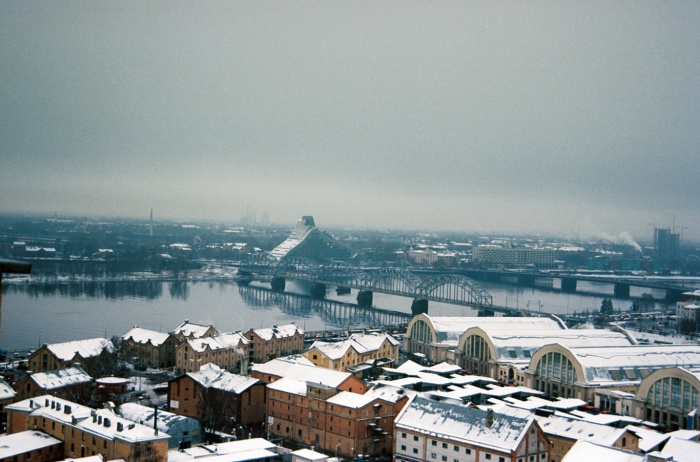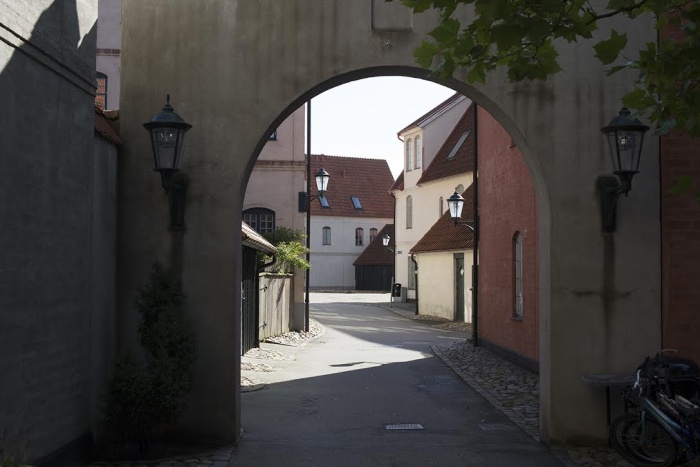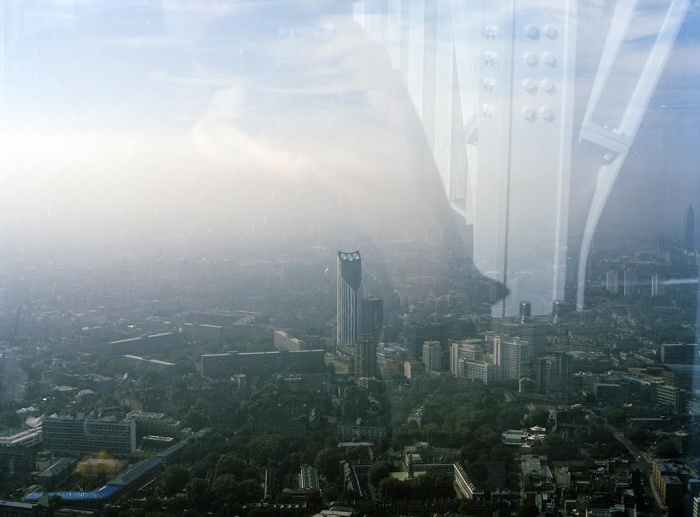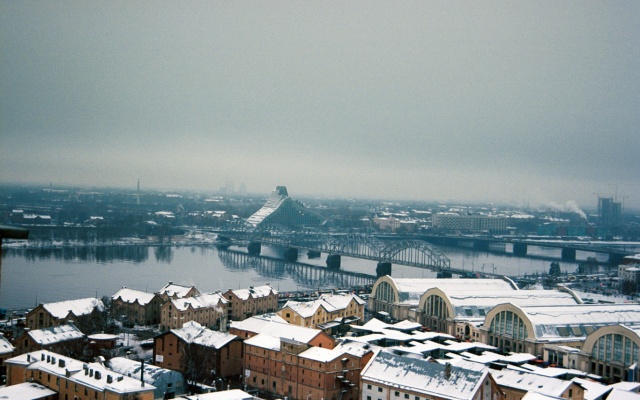
Łotewska Biblioteka Narodowa, 30 listopada 2012. Zdjęcie: Patrik Aarnivaara
This essay is a collaborative and individual thought process. A continuation of projects that have evolved from an interest in horror films as a genre where certain aesthetics and fear are often constructed by means of architecture. The research, under the title Scenography of Horror, began during a Nordic-Baltic collaboration residency at the Helsinki International Artist Programme (HIAP) in December 2013 and continued as an extensive exhibition project The Primal Shelter is the Site for Primal Fears which took place at The Living Art Museum in Reykjavik in 2016. As the research develops, we are constantly exploring other forms and formats of expression in relation to this topic.
Taking our working method from previous projects, working individually on a common subject while unfolding it collectively, this short essay is divided into two separate parts approaching the notion of ghost architecture. We try to look at it as something that goes beyond the cliché of haunted spaces, abandoned buildings, and ruins. It is the architecture that, from our viewpoint, is still living among us, fully functioning and alive – encompassing the particular modes of meaning in today’s society, serving the purposes of ideologies and power.
The texts are brief speculations on how architecture in different forms can be seen as ghost architecture. It is part of an ongoing thought process about the phantoms of architecture, or those produced by it.
1. Maija Rudovska
What is ghost architecture? Is it a forgotten park, an abandoned building, a run-down square? These examples come to my mind when I think of the concept. It has to be something that has expired, that is alienated, forgotten – something that we no longer want to deal with or engage with. Yet what if it is something present and alive, existing, and needed? Paradoxically, ghosts could be both: they are absent and present at the same time, wandering around and haunting us. They live in parallel or concatenated with a reality that is visible to us.
Ghost architecture could be architecture that takes the past as its inception in order to project the future, combining layers that are in uncanny relationship with each other. It’s the architecture which mimics and repeats; which alienates and distances itself from the here and now, gravitating towards aloofness. It’s also architecture that engenders fear and holds power by subtly constituting the space, determining behaviors and movement, therefore imposing attitudes and values. It can also be architecture that is obsolete in terms of its appearance, shape and meaning yet may be gaining momentum due to nostalgia.
One of the best examples to illustrate the idea is perhaps Stalinist architecture or in general totalitarian architecture and its existence in the 21th century. It is very hard to deal with it because we can't figure out where it stands; it just doesn't fit in. That architecture was entirely detached from reality, conceived under a regime and ideological constraints – built in a dreamlike state, alienated in every possible way. A while ago I was researching Stalinist architecture which, at that time, I found very appealing particularly because of its absence in time and place. There was something about it that was not current anymore; no longer alive and real yet at the same time there it was – in front of my eyes, still existing. I could touch it, enter it, and experience the presence of its body but it was almost like a dead body. Literally it is a dead body because most of the buildings have been abandoned, destroyed, emptied. Apart from the uneasy physical presence, they have been haunting since their inception. Anything contemporary seems too awkward in relation to them.
Ghost architecture we can find everywhere – not only in the past but also in the present day. There is an undefined and changing presence of such architecture – which is why it could be called ghost architecture. It slips from one context to another, changing its meaning, importance, and content: sometimes it disappears, at other times it reappears, as has happened in many cases with cities and buildings that try to repeat or mimic the past, or that aim for new forms that embody the old functions like the city of Warsaw which was recreated after its destruction during WWII, or other similar examples.
For me, personally, the implications of the concept could be applied to a particular example in Riga – the building of the Latvian National Library which in collective memory is promoted as the Castle of Light, embodying the discourse of enlightenment in the 21th century. Visually resembling a hill with a crown on top of it, the building was shaped in accordance with a nationalistic agenda and its appearance has slightly changed since the idea behind it was devised by Gunnar Birkerts, an internationally recognized Latvian-born architect. Regardless of the building's seemingly post-modernistic image, it is a perfect example of ghost architecture that is fully alive today. It stems from the ideological imagination, taking an old notion of shape and function that turns into an awkward manifestation of the same nationalistic idea. Even the post-modernist aesthetic doesn't save it from silliness. At the same time the building has its function in collective memory, it helps to maintain the identity of an imagined community that has stayed strong during times of occupation and invasion, and strengthens the imaginative aspect of this identity.
What is ghost architecture yearning toward and what does it aim to achieve? Why has such architecture been important in our past and is growing in importance even more today? Juhani Pallasmaa puts it like this: “Man-made structures ‘tame’ the world for human habitation and understanding, but they also enhance its sensuality and desirability”1 which means that ghost architecture aims to fulfill a certain purpose. It is meant to remind us of traumas and the past, perhaps in a very cruel and painful way, as sometimes it takes the shape of awkwardness and a moldering appearance. Many times this kind of architecture express itself as “Other,” something unfamiliar and different, out-of-date, and alienated. The otherness might be uncanny. As Nicholas Royle points out, it may be “... constructed as a foreign body within oneself, even the experience of oneself as a foreign body, the very estrangement of inner silence and solitude. It would appear to be indissociably bound up with a sense of repetition or 'coming back' – the return of the repressed, the constant or eternal recurrence of the same thing, a compulsion to repeat.”2
2. Patrik Aarnivaara
“The screen loomed above me, a clouded mirror drained of its memories.”3
Generally speaking, a ghost is considered to be the visible soul of a deceased person – an immaterial shadow image of its host. Lacking a spirit, but definitely casting a shadow, ghost architecture could be thought of more as a replica, an identical copy, a soulless body with a shape and surface similar to the original building, but constructed in contemporary materials and set in a new context. Its resemblance to the original building evokes mixed feelings of strangeness and uncanniness and, at first, a pleasant, but eerie, homely feeling engendered by seeing, approaching, and entering a space that looks familiar.
Berliner Schloss was torn down to make way for Palast der Republik, which was torn down to make way for Berliner Schloss. The memory of Palast der Republik is still fading while the reconstruction of Berliner Schloss appears as a death mask of the original building. What could be understood as a ghost? Is it the transparent image reminiscent of the previous buildings that superimposes itself over the new building, like a double-exposed image producing a “discontinuous flux of events taking place on both sides of the retina?”4 Is the reconstruction of the castle a kind of exorcism to expel a ghost from the recent past, while eventually producing an even stronger feeling of separation and strangeness by invoking memory images of two buildings on a single site?
A similar feeling is captured in Yuki Higashino's video work Poundbury Horror, which interweaves cinematographic conventions from architecture and horror films to document a small town on the outskirts of Dorset. The town is designed by Prince Charles of England and built according to architectural principles of traditional English neighborhoods. Its ghostly architecture resembles other building projects across Europe, that are guided by reactionary ideas looking to simulate and recreate an idealized past, to oppose modern and foreign architectural influences. “When this fiction is imposed on architecture, which encloses every human activity, it is akin to some kind of dark force pervading human space. Poundbury is an architectural equivalent of such a horror story, with Prince Charles cast as the black magician in this political narrative.”5

Jakriborg, 14 września 2017. Zdjęcie: Patrik Aarnivaara
The prospect of a future with cities of replica architecture creates a specter for a dreadful horizon, a space congested with phantoms of the past, it is a future without any surprises. Just like the example of Poundbury it is a future re-enacting architecture of the past while blocking any promise of a contingent future. Visiting Jakriborg, outside Malmö in Sweden, a small village built in the 1990s in a medieval Hansa style, what struck me most was the constant breaks and glitches in the Medieval-looking building's fabric by modern elements such as cars, bikes, food advertisements, and the diverse belongings of tenants inside and outside the apartments. The clash between the staged time and contemporary time left a feeling of a semi-rundown amusement park, while the illusion of a medieval city remained intact only for a few moments and from very specific viewpoints.
In the center of Fedora, that gray stone metropolis,
stands a metal building with a crystal globe in every
room. Looking into each globe, you see a blue city,
the model of a different Fedora. These are the forms
the city could have taken if, for one reason or another,
it had not become what we see today.6
The presence of the pre-war city in the post-war city that is built on its rubble, or the large-scale demolition of older buildings replaced by modern concrete buildings throughout Swedish inner cities in the 1960s and afterwards created phantoms of previous cities that “actively insert their memory into the fabric of our existence”7 through archival images, memories, and perceptions as well as the remaining buildings. The story about the fictional city of Fedora in Italo Calvino’s book Invisible Cities lets us imagine not only the past developments of a city, but also its possible futures. These ghosts of possible cities let us imagine a contingent city, which haunts us from the past as well as the future.

Widok z budynku The Shard, Londyn, 10 października 2012. Zdjęcie: Patrik Aarnivaara
Inside the crystal globe of neo-futurism a sinister darkness prevails amongst the uninhabited and empty investment properties next to construction sites with buildings spiraling towards the sky like a bar chart. A ghost streetscape is created by means of a computerized regime of camera eyes, radars, satellite images, and sensors mapping the body of the city: a virtual replica city in parallel with the physical city, a second skin impossible to molt.
Together the virtual and physical architecture driven by capital flows creates a protected inner-city island that replicates itself globally and in the present. Spaces where the presence of humans is superfluous, it is an architectural entity produced by humans but belonging to architecture. It is architecture trying to insure itself “against mortality”8 by liberating itself from its human flesh.
BIO
Patrik Aarnivaara (b. 1977) is a Swedish artist based in Malmö. He studied fine art at Malmö Art Academy, Valand Academy in Gothenburg, and Goldsmiths in London. His work is influenced by the interaction between viewers, optical devices and architecture, employing sculpture, video and photo-based works to explore the act of observation.
Maija Rudovska’s practice is shaped by independent curation, research, art criticism, and writing. The focus of her work is inter-mediation and stimulation of relationships between spaces, contexts, and institutions. She has worked extensively in the Baltic-Nordic region, curating exhibitions and projects at kim? Contemporary Art Centre (LV), Moderna Museet Malmö (SE), Contemporary Art Centre Vilnius (LT), The Living Art Museum (IS), etc. She has written for FlashArt, Calvert, Guardian, International Awards for Arts Criticism, Echo Gone Wrong, and other published and online media. Rudovska is based in Riga (LV).
* Cover photo: National Library of Latvia, 30 November 2012. Photo: Patrik Aarnivaara
[1] Pallasmaa, Juhani. The Embodied Image. UK, John Wiley and Sons Ltd, 2011, p.119.
[2] Royle, Nicholas. The Uncanny. UK, Manchester University Press, 2003, p.2.
[3] Ballard, James Graham. Millenium People. Paris, Gallimard, 2006, p. 121.
[4] Ballard, James Graham. “Images of The Future: Comments on some recent experiments.” JG Ballard: Images of the Future, JGB NEWS, 19 Jan. 1993, www.jgballard.ca/non_fiction/jgb_images_future.html. Accessed 22 Sept. 2017.
[5] “The Primal Shelter is the Site for Primal Fears.” The Living Art Museum, 2016.
[6] Calvino, Italo. Invisible Cities. London, Vintage, 2009, p. 32.
[7] Meillassoux, Quentin. Collapse: Philosophical Research and Development. Translated by Robin Mackay, IV, Falmouth, Urbanomic, 2012, p. 262.
[8] Comaroff, Joshua, and Ker-Shing Ong. Horror in Architecture. San Raphael, ORO editions, 2014, p. 49.



